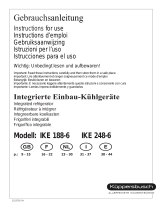Instructions for the use of the instructions booklet
Notes which are important for your safety or for the proper functioning of the appliance
Supplementary information regarding operation and practical applications of the appliance.
Tips and notes concerning economical and environmentally sound use of the appliance
t
Printed on paper manufactured with environmentally sound processes
Child Safety
¥ This appliance is designed to be operated by
adults only. Do not allow the children to tamper
with the controls or play with the products. There is
a risk of suffocation! Keep packaging material
away from children!
Environment Protection
¥ This appliance does not contain gasses which
could damage the ozone layer, in either its
refrigerant circuit or insulation materials. The
appliance shall not be discarded together with the
urban refuse and rubbish. Avoid damaging the
cooling unit. Information on your local disposal
sites may be obtained from your municipal
authorities.
Remove the plug and ensure that any locks or
catches are removed, to prevent young children
being trapped inside.
Safety Instructions
This information has been provided in the interests of your safety. Please read it before installing or
using the appliance. Please retain the instruction book for future reference. If owner ship is transferred,
please leave the user manual for the new owner.
Domestic Use
¥ The domestic refrigerators and freezers are
designed to be used specifically for the storage of
edible foodstuffs only.
¥ Check the appliance for transport damage. Under
no circumstances should a damaged appliance be
installed. In the event of damage please contact
your retailer.
¥ This appliance is heavy. The edges and projecting
parts of the cabinet may be sharp. Be careful when
moving the cabinet and always use gloves.
¥ Any electrical work required to install this appliance
should be carried out by a qualified electrician or
competent person.
¥ Make sure that the power plug is not squashed or
damaged by the back of the appliance. Make sure
that the cable is not trapped underneath the
appliance, nor touches the motor.
¥ Do not remove the power cord by pulling on its
lead, particularly when the appliance is being
pulled out of its niche. If the power plug socket is
loose, do not insert the power plug. Damage to the
cord may cause a short-circuit, fire and/or electric
shock.
¥ Do not use electrical appliances inside the
appliance.
¥ Do not keep carbonated drinks or bottles in the freezer
compartment. The glass bottles may break.
¥ Ice lollies can cause Ôfrost/freezer burnsÕ if
consumed straight from the freezer.
¥ It is dangerous to try and alter the specifications or
modify this product in any way.
¥ Under no circumstances should you attempt to
repair the appliance yourself. Refer to your local
Service Centre, and always insist on genuine spare
parts.
Disposal
Appliance Packaging Information
¥ The materials marked with the symbol are
recyclable.
>PE< for polyethylene, e.g. sheet wrapping
material
>PS< for polystyrene, e.g. padding material
(always CFC-free)
>POM< polyoxymethylene, e.g. plastic clips.
All materials are environmentally sound!

















